Landscape Irrigation
Landscape Irrigation
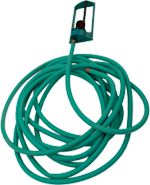
The primary goal of installing a water-wise landscape is to reduce the need for supplemental irrigation while still maintaining a healthy and attractive landscape. The water needs of the landscape are determined by the local climate, plant type, the time of year, and the desired quality of the landscape. In many areas of North America, a well-designed water-wise landscape can thrive with little or no irrigation water once it has been established.
Good irrigation design and scheduling are essential for maximum water efficiency. Irrigation design consists of the type of sprinkler system (manual or automatic) and the layout of the sprinkler system. A properly designed and well-managed system will apply water only when it is needed and only the amount necessary to replenish the soil moisture that has been lost due to evaporation from the soil and transpiration from the plants.
Important facets of landscape irrigation are shown below:
- Manual or Automatic Irrigation
- Irrigation Design and Installation
- Irrigation Scheduling
- Irrigation System Maintenance
- Irrigation Tips
- Smart Irrigation Technologies
- Leak Detection and Repair
Manual or Automatic Irrigation
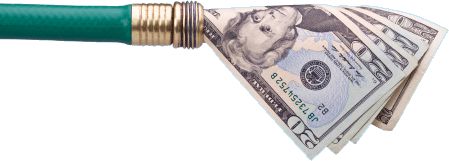
There are two basic ways to water: manually (hand watering) with hoses and sprinklers or nozzles, or automatically with clock-driven, in-ground irrigation. You may decide to use manual or automatic irrigation, or a combination of both.
How you chose to irrigate your landscape will depend on several factors including the following:
- Size of the irrigated area. Manual irrigation of small areas is more easily managed than irrigating large areas which may require moving hoses and sprinklers frequently. If the area to be irrigated is kept small and regular in shape manual irrigation can be very easy to manage. There are many inexpensive timers available for use with manual irrigation that can be attached to the hose bib that allow irrigation with multiple hoses, and have features such as multiple schedules, cycle and soak, and time of day watering.
- Water demand. Once established, many water-wise plants may require only occasional supplemental irrigation during prolonged dry spells or during the hottest part of the summer. High water use plants such as turf require more irrigation, applied more frequently, than the rest of the landscape.
- Irrigation frequency. During the hottest part of the summer turf may require irrigation three times a week to maintain a healthy appearance. Homeowners that travel frequently or are gone for extended periods during the summer may find it difficult to maintain a landscape using manual irrigation.
- The cost of water. Households with automatic systems, on average, use twice as much water outdoors as households that water manually. Most water used for irrigation is treated to drinking water standards and as a result is often very expensive. In an effort to reduce water use for "non-essential" uses many utilities have instituted tiered-rate structures, water budgets, or seasonal rates which can result in a substantial increase in cost for the water used for irrigation.
Automatic Irrigation Systems
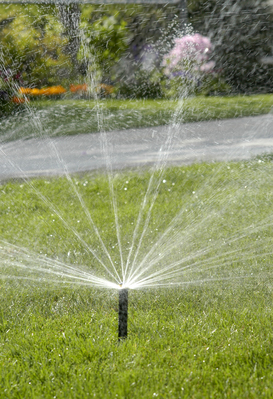
Automatic sprinkler systems are more expensive to install and maintain than manual irrigation. Professional services may be required for installation and some of the maintenance. The typical home irrigation system is only about 40-50% efficient. That means that half of the water applied to the landscape is wasted and not benefiting the plants.
Several keys to improving the efficiency of your automatic irrigation system are 1) a well-designed and properly installed irrigation system, 2) scheduling your irrigation controller to apply the right amount of water in the right way and at the right time and 3) proper maintenance of your irrigation system.
Manual Irrigation System
Manual irrigation is more efficient and less expensive than installing an automatic irrigation system. Very little maintenance is required and the maintenance that is necessary can easily be performed by most homeowners. Manual irrigation systems are however more time intensive than automatic irrigation. There are some things you can do to make manual watering easier and more efficient:
- Always use a spray nozzle with a shut off valve when hand watering. A watering wand or nozzle with a shut-off in the handle is a good choice.
- Use soaker hoses and drip irrigation to water flower beds, vegetable gardens, shrubs and trees. Both of these irrigation methods efficiently deliver water to the root zones of plants and can be connected to an ordinary hose.
- Attach a timer valve to your outdoor faucet. This will allow you to run your sprinklers or soaker hoses for a pre-set amount of time and they will shut off automatically.
- Use quick connectors. These reduce the amount of time required to connect and disconnect hoses. They also reduce the leaks that can occur when screwing two hoses together.
Irrigation Design and Installation
Whether the irrigation system is designed by you or a professional the following recommendations will improve the efficiency of the irrigation system:
- Like the plants in your landscape, plan the irrigation system so that it has room to grow - sprinkler heads can be added as necessary as the landscape matures. The zone capacity is dependent on the flow rate coming into the system, the flow rate of the sprinkler heads and the pressure of the system.
- Know your pressure - pressure that is too high or too low can have a significant impact on the efficiency of the irrigation system. Pressure should not be within 10% of the low or high end of the specifications set by the manufacturer. System pressure should be tested during normal operating hours of the sprinkler system. This generally means after 6PM and before 10AM. This allows for fluctuations in pressure from the water utility. Pressure should not exceed the specification of the manufacturer which leads to premature wearing of parts and misting.
- Match precipitation rates - in other words if a full circle sprinkler head puts out 10 gallons (37.9 L) per minute, to match the precipitation rate a half circle head should output 5 gpm (18.9 Lpm) and a 1/4 circle head 2.5 gpm (9.5 Lpm).
- Don't mix sprinkler head types or manufacturers on the same zone. Pop-up spray heads and rotors have very different flow rates and different manufacturers have different design performance criteria for optimizing performance.
- Pop-up spray heads and rotors should be in turf areas only. All other beds, trees and shrubs should be irrigated with drip system.
- The system must meet the design specifications and achieve a minimum level of efficiency. Efficiencies of 75% or better are achievable. An audit should be performed on sprinkler system once it has been installed. Many water utilities offer free irrigation system audits as a service to their customers. It's a great way to learn how to water your landscape more efficiently.
Drip Irrigation
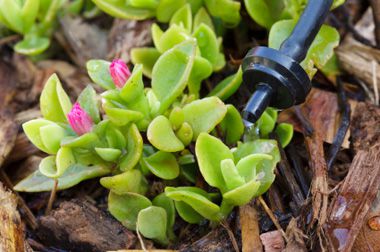
Drip irrigation can be operated either manually or as a zone or zones on an automatic sprinkler system. Drip irrigation applies water to the root zone of the plant at low pressure and low volume, making efficient use of water. Water is delivered where plants need it–around the root zone. Because it is applied slowly on or near the ground, no water should be lost to runoff or evaporation. The amount of water delivered can be controlled by varying the length of time the system runs or the type of emitters.
Drip irrigation is easy to install, inexpensive compared to overhead sprinkler systems, and can reduce disease problems associated with high levels of moisture on some plants. Most home improvement stores carry some drip kits, but go to an irrigation supply store for advice and a full line of drip irrigation components.
Drip Tips
- Drip irrigation can take the form of emitters, microsprays, or soaker hoses.
- Drip is the preferred method of irrigating trees, shrubs, and vegetable gardens, but it is generally not recommended for continuously rooting ground covers.
- Subsurface drip can be used to irrigate lawn areas. Emitter lines are buried 4 to 8 inches below the lawn or soil surface and are usually spaced 12 to 18 inches apart. Water from the emitter line spreads slowly through the soil to irrigate the lawn or plants.
- Overhead irrigation systems can be converted to drip with retrofit heads (see below).
- Drip systems can be connected to a hose end and manually operated, or be permanently connected to your main water source and operated by an automatic controller.
- Plan enough capacity (emitters) for when your landscape matures. Use the product's emitter selection chart to determine the flow rate and number of emitters per plant.
- Polyethylene ("poly") tubing on the surface in areas of heavy foot traffic or children's play areas can easily be broken, disconnected, or vandalized.
- Dogs, raccoons, gophers, and other animals can chew tubing and emitters. If this is a problem, use rigid pipe (polyvinylchloride or PVC) and protection for emitters.
- Drip irrigation needs to be regularly maintained to check for leaks and clogged heads. Keep your system as simple as possible to lower maintenance. Half inch diameter drip line with the emitters built into the line is highly recommended to minimize maintenance.
Irrigation Scheduling
Evaluate the water needs of each irrigation zone
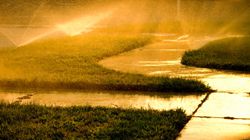
Irrigation scheduling begins with an examination of the plants to be watered, sun exposure, and the soil type. Some general guidelines are presented below (ask your local university cooperative extension office or library for a regional plant guide for more specific information):
- Turf grasses, annual flowers and vegetables are usually high water using plants. Turf grass is shallow rooted and fast growing and requires more frequent irrigation. Cool season grasses such as Kentucky blue grass need considerably more water than warm season grass varieties such as centipede, bermuda, or buffalo grass.
- Ornamental shrubs and ground covers may use 40% to 60% less water than turf or annual flower beds.
- Regionally adapted plants are often low water using plants, and may use 60-90% less water than high water use plants.
- Drought resistant plants, including many regionally adapted and native plants, may thrive on minimal or no supplemental water. Many of these plants can survive strictly on seasonal rainfall once they are established.
- Newly planted plants need to be watered more frequently until their root systems are established, usually 2 to 3 years, after which irrigation should be scaled back.
- Potted or container plants dry out more quickly than those in the ground and therefore require more frequent watering.
- Plants in full sun areas of your yard often require about 30% more water than shady areas.
- Plants in sandy soils require shorter more frequent irrigation than clay or loam soils because of the lower water holding capacity of sandy soil.
Irrigation Scheduling and the Irrigation Controller (a.k.a. Irrigation Timer or Clock)
The controller is the heart of your irrigation system. It works by turning on and off the different valves for the various irrigation zones in your yard. Each zone can be scheduled to irrigate for a specific length of time according to the water needs of the plants in that zone. For example, the irrigation zone for a sunny lawn area should be set to water more than a zone for shady lawn or for drought tolerant shrubs. If your landscape and irrigation system are designed properly, your plants should be arranged into groups based on their water needs (called "hydrozones") and your irrigation system will have separate irrigation zones for each of these plant groupings. Modern home irrigation controllers are capable of handling 6-12 irrigation zones and each zone can be programmed to water on its own schedule.
A well-designed irrigation controller has these features:
- An adequate number of zones with expansion capability that allows for the addition of zones
- Runtime increments of one minute. Capable of running for several hours (drip irrigation)
- Minimum of 4 programs. Allows you to water turf zones 3 times a week and low water use zones less often.
- Multiple cycles or start times with soaking time between each cycle–also known as cycle and soak. This is particularly important when irrigating turf areas, clay soil, or slopes where long irrigation runtimes result in run-off and wasted water.
- Ability to operate the controller manually and operate each zone individually
- Percent adjustment–rather than reprogramming the controller–the runtime can be increased or decreased as a percentage of the original program.
- Non-volatile memory. No battery required. Won't revert to a default program that is one size fits all.
- Ability to add rain, soil moisture, or wind sensor.
Remember, you are the brains behind your controller because you set the irrigation schedule for each zone. Properly setting irrigation run times is one of the most important things you can do for landscape health and water savings. The basic concept is simple: each irrigation zone should be set according to the water needs of the plant grouping.
Irrigation System Maintenance
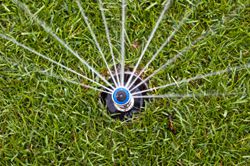
We have all seen misaligned sprinklers watering the pavement and broken sprinkler heads spouting in the air like geysers. Regular system maintenance is critical to efficient irrigation and a healthy landscape. Observe your system in operation frequently during the irrigation season. Turn on each irrigation zone individually and see whether water is reaching all the areas it's supposed to and not unintended surfaces such as driveways. Tips for fixing common problems and routine maintenance are presented below:
Misaligned Heads and Emitters - While the system is running, turn the sprinkler body on the pipe to which it is connected to reposition the spray of water. Or if their sprinkler has a ratcheting stem, twist the stem of the sprinkler. Loose nozzles are more likely to move on their own while popping up and down and more easily aim themselves in the wrong direction. Some pop-up heads have a radius adjustment screw or the nozzle can be twisted to change the radius of the spray pattern. For drip irrigation, check to see that the emitters are applying water to the root zone of the plants.
Low Flow or Misting Heads - Most pop-up spray heads have an adjustment screw on the top of the sprinkler nozzle to adjust flow. Rotary sprinkler heads have a diffuser screw to adjust the distance of the throw. Turn clockwise to decrease flow and counterclockwise to increase flow. If the flow is still not adequate, your water pressure may be too low or the head may be clogged. Open the control valve fully for that irrigation zone to increase pressure. If heads are misting, the water pressure is too high and the control valve should be turned down until a proper spray pattern is achieved. Alternatively, a pressure regulator can be installed to reduce pressure. If pressure is too low, your system may have been designed improperly and there are too many sprinkler heads or emitters on the irrigation zone, or you may have a system leak (see leak detection below).
Stuck Heads - Sometimes pop-up sprinkler heads will stick in the up position. If you already use spring loaded pop-ups the problem is most likely caused by sand or debris stuck in the wiper seal. Unscrew the spray head cover to clean whatever is stuck in the wiper seal. If this doesn't correct the problem buy a new head with the same application rate and pattern. Choose a pop-up heads with a height of at least 4" to clear the grass.
Obstructed Heads - Growing grass or shrubs can block the spray pattern of sprinkler heads resulting in poor coverage. Keep lawn mowed and shrubs pruned to prevent this. As your garden grows, this may no longer work, in which case you can install taller risers for the sprinkler heads, or replace short pop-up heads with 4 or 6 inch pop-up heads.
Head Replacement - Heads and nozzles are relatively inexpensive. If they're clogged, broken, or stuck, you can replace them quite easily. Sprinkler heads are usually threaded and screw into a connection buried in the ground as part of the pipe network. To replace a broken head, first dig out all the dirt around it. Firmly hold the riser pipe under the sprinkler head with one hand while unscrewing the sprinkler head with your other hand. Avoid getting dirt into the riser. Take the broken head with you when you buy a new one to make sure you get one that matches, with the same spray pattern and application rate.
Clogged Heads and Emitters - Debris in the pipes can clog sprinkler heads resulting in uneven coverage. To prevent this you should flush your system once a year. Remove the nozzles and filters from all the sprinkler heads and turn on the water for a few minutes to flush the system. Rinse the filter and clean the nozzles. Use an old tooth brush, tooth pick or wire to remove any stuck debris. Calcium buildup can be removed using one of the many calcium remover products available for kitchen use. If after flushing the system you still have some nozzles that aren't working properly it's best to replace them.
Irrigation Tips

The following are some additional tips that will allow you to irrigate your landscape more efficiently:
Water deeply and infrequently. Once you have evaluated the water needs of each irrigation zone in your yard, how should you schedule the controller to apply the water? Everyday? Once a week? The answer is to water deeply and infrequently, allowing the top 1” of soil to dry in between irrigations. This will promote deep root growth and healthy plants.Determine the root depth of the plant crop and irrigate to fill that root zone. Watering too deeply, beyond the root zone, wastes water. Turf has relatively shallow roots which is why it must be irrigated more frequently, but less deeply. Most shrubs have deeper root zones and trees generally have the deepest root zone. The height of the plant above ground can be a general guide to the relative depth of the root zone of the plant. Limiting irrigation to frequent, shallow irrigation can force surface rooting of plants that otherwise would have deeper roots and a large reservoir of water on which to draw during hot spells.
On days you water, cycle your sprinklers on and off so that the water has time to soak into the ground. Sprinklers usually apply water at a rate faster than the soil can absorb it. This causes wasteful runoff and is a problem particularly when irrigating on slopes or irrigating heavy clay soils. Fortunately, solving this problem is easy. Most modern irrigation controllers offer the option of 2 or 3 irrigation start times per day. Here's an example: Instead of scheduling your system to water once for 15 minutes, use the multiple start time feature and set up three start times of 5 minutes each. The period between start times will allow the water to absorb deeply into the root zone and should eliminate run-off. When irrigating manually reduce the flow rate of the sprinkler and move the sprinkler frequently. Note: multiple start times are not recommended for drip irrigation systems because drip systems use very low volume emitters.
Adjust irrigation according to the weather and seasons. Plants require considerably more water in hot dry months and may require little or no irrigation in the cooler months. Cut back on irrigation during cooler months and turn off your system in the winter. Newer sprinkler controllers have a percent increase/decrease feature. This feature enables you to reduce or increase watering across your entire system by a fixed percentage. This feature makes it much easier to adjust your clock for seasonal changes.
The weather can change on a daily basis. Don't forget to turn off your irrigation system if it's expected to rain and keep it off for several days until the soil dries out. Some sprinkler controllers have a convenient rain pause button that enables you to postpone irrigation for a day or more. Relatively inexpensive rain or soil moisture shut-off devices may be added to irrigation controllers which automatically turn off your irrigation system if it is either raining or the soil is wet.
Replace spray heads with new rotary sprinklers. Lawn areas can be irrigated more efficiently with new multi-stream rotary sprinklers. These sprinklers have multiple rotating streams which improves the uniformity of coverage (efficiency) by 30% over conventional spray heads. The droplets of water emitted are larger than from conventional sprayheads which reduces evaporative losses and misting. They also have a lower output than conventional sprayheads which means better soil infiltration and less run-off. If you decide to replace existing spray heads with rotary ones you will have to replace all the heads in that irrigation zone because they have a lower water application rate. Some models allow you to change out just the nozzle in your existing spray head body. Choose nozzles with the appropriate "throw" range and pattern so you get head to head coverage. You will also need to increase the run-time on your sprinkler to compensate for the lower flow rate.
Smart Irrigation Technologies
Major advances in controller technology have occurred in recent years. New "Smart Controllers," also known as Weather Based or ET Irrigation Controllers, schedule irrigation according to actual water needs of plants by using information such as weather, climate, plant type and the soil type of your landscape. Smart controllers take much of the guess work out of programming a traditional controller and have been shown to save about 20% on irrigation water use. Smart controllers and rain shutoff devices are discussed further below.
Smart Irrigation Controllers
Imagine your sprinkler system could automatically adjust its program in response to changes in the weather to deliver the right amount of water to each plant zone. During hot and dry periods, your system would water more frequently and for longer periods of time. After a heavy rain, your system would not resume irrigation until needed.
Well now you don't have to imagine! Several companies now manufacture irrigation controllers that apply water based on the evapotranspiration (ET) rate. ET is a measure of the amount of water required to maximize plant growth given the prevailing temperature, precipitation, cloud cover, etc. Smart controllers have been shown to reduce water use by more than 20%, while maintaining or improving landscape health. Smart controllers are now becoming standard equipment for new irrigation systems and may be cost-effective for retrofitting existing systems depending on landscape size and water use.
Smart controllers use a variety of technologies to schedule irrigation. Some rely on a network of weather stations that transmit daily data (via the web or a pager) to the controller to adjust the irrigation schedule. Another type has a built in "ET chip" that contains a detailed 20-year history of ET for your region and irrigate based on historical patterns combined with a small temperature sensor. Other smart controllers use on-site rain sensors and/or several soil moisture sensors. The computer schedules the irrigation everyday based on the amount of moisture present in the soil.
Currently, smart controllers cost upwards of $400, but the price is coming down as the technology becomes more widespread. They are relatively easy for the homeowner to install, and some water utilities are offering financial incentives for customers to convert to smart controllers (Check with your water utility). A less expensive retrofit module is now available for some common brands of controllers. The retrofit module plugs into the existing controller making it a smart controller. Contact your controller manufacturer to see if a retro-fit module is available.
Rain/Moisture Shutoff Devices
Rain and soil moisture shutoff devices automatically turn off your irrigation system if it is either raining or the soil is wet. They do not adjust scheduling like a smart controller, but at least you won't be irrigating in the rain.
Rain shutoff devices and soil moisture sensors are inexpensive ($25 - $100) and easy to install on just about any sprinkler controller. These products have been proven to save water and money. Some cities and states now require one of these devices to be installed on all new sprinkler systems. Check with your local water supplier to find out more about requirements in your area. A rain shutoff device works well in conjunction with conscientious irrigation management.
Leak Detection and Repair
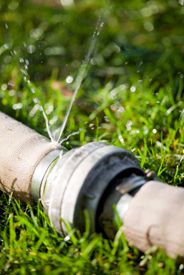
System pipes and joints may develop leaks or an automatic control valve may fail to shut completely. Indications of leakage include an unexplained rise in your water bill, poor system performance, dry spots, soggy areas in your yard, overgrown areas of turf, erosion and/or subsidence.
For drip irrigation the supply poly-pipe may be damaged by foot traffic or by gnawing and chewing animals. Leaks in drip irrigation systems are easy to detect if the supply lines are only covered with mulch. Visually inspect the drip lines while the system is running. Tighten clamps at leaking joints. Small line leaks can be repaired with plugs.
Tracking down a leak in your sprinkler system is a bit more involved. Locate your water meter. The water meter is usually located in the front yard in a ground box near the street or in a basement. Turn off everything indoors and outdoors that uses water. If the dial on the water meter is moving, you've got a leak. To check for a slow leak, write down the meter reading and wait twenty minutes or so to see if there is any movement on the meter. (You can also use your water meter to measure the amount of water applied to your landscape and to track water use.)
If you have a leak in the irrigation system it's probably in one of the control valves (toilets are another frequent source of leaks). To test for leaks beyond the control valves in the actual system piping you will have to cap off the sprinkler heads, then run each irrigation zone one at a time, checking your water meter for movement. If the meter is indicating a leak, look for water appearing at the surface to locate the leak. Repeat for each irrigation zone. Locating a slow leak may require the services of a professional.

